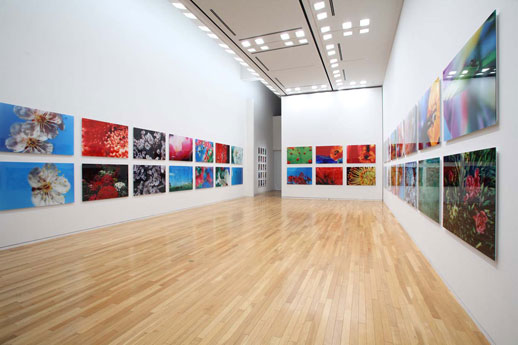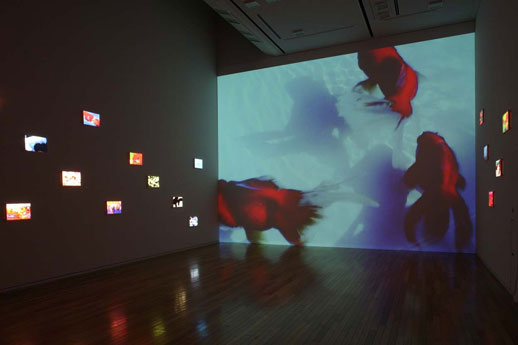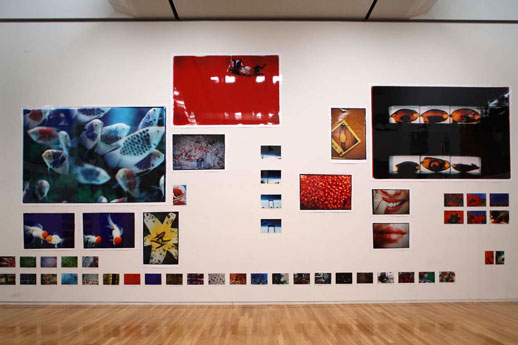The Fly in the Technicolour Ointment…
Walking through this exhibition feels like flipping through the pages of a glossy magazine. The show begins with an eye-catching cover: the image on the exhibition poster — a gloriously pink flower — is taken from the opening room, adorned with Acid Bloom (2003), a series of large photographs of vibrantly coloured close-ups of flowers interspersed with other pictures that resemble the view from the flowers. Indeed, the first-time viewer of Ninagawa’s work will realise before even arriving at the gallery that her photography is not exactly defined by subtlety or self-restraint.

As the accompanying handout mentioned: “Melting outlines, quickly fading boundaries. Am I a flower, or is the flower me?” the impression one has is that the artist and the flowers share a similar perspective: one of looking whilst being looked at. However, little was I aware that the boundaries between these works and my mind were also beginning to melt.
The show segued into what would be a magazine’s editorial section: a room full of her early works from time spent on Isla Mujeres, an island in the Gulf of Mexico in the late 1990s, but it was the feature pages, as it were — video footage of goldfish, celebrity portraits, still lives of artificial flowers and portraits of animals — that subsequently caught my attention, not to mention what would be the Ninagawa equivalents of adverts and listings — a wall of purikura sticker style portraits of women posing cutely for the camera.

Liquid Dreams (2008), a wall-sized video projection of goldfish swimming around a tank, is perhaps poor in terms of technical quality, but ultimately it is its banal treatment of subject matter that lets it down: this video of fish is simply a video of fish and has little further depth to it. The scale of the fish however harked back to the equally large flowers seen earlier — a scale which seemed intent on overpowering me. The smaller works in the “editorial section” had allowed me to begin to engage with her work on an intellectual level but I was dropped back into a world where flowers and fish were as big as I was. Again, I felt insignificant.
It was then that I noticed the fly. Titled Floating Yesterday (2004-05), the fourth room presented an installation of various photographs, with one particular image depicting brightly coloured round objects with a small fly resting on them. For all the persistent use of bright colours, I didn’t notice the insect at first but once I had, I not only felt sympathy for the fly’s situation but I realized that we might both be trapped in this uncertain world of bright colours and exaggerated scales. Walter Benjamin once spoke of consciousness providing “not a means of making sense of sensory stimulation, but a shield against it”. My shield had been officially breached and I needed to get out. However, I was only half way through.
Ninagawa’s celebrity portraits, Ninagawa Land (2004-08), featured in a room with a disco-like chequered floor, were yet another indulgence of bright and lurid imagery, albeit informed by Japanese popular culture, and it only exacerbated the sensory overload. It seems the curators have tried to offer viewers some respite by then plunging them temporarily into darkness in the following room: Everlasting Flowers (2005) where pictures of artificial flowers have been displayed under spotlights. I was told that these artificial flowers could only have been made in Mexico because of their brightness and high quality but at this point I may well have ceased caring. A room such as this perhaps came a little too late and in this case it was the exhibition design that let down the work rather than the other way around.

Thereafter, with the exit beckoning, a larger room: Noir (2007-08) with a Wolfgang Tillmans-esque display of varyingly sized prints pinned or taped to the wall held my attention, but frustrated me. The larger works here in particular, being printed on four separate pieces and then hung on the wall as if taped together may well have been a conscious allusion to the fold-out pages of magazines, but the apparent contradiction between the domestic subject matter and the ad-hoc appearance of their display seemed contradictory or even lazy.
The show concludes with a long wall of yet more celebrity portraits displayed as though they were large purikura stickers, and it induced my first ever physical shudder in an art gallery as I made my way to the safety of the exit. While it may not have suited my taste, there is of course a market for this kind of work and Ninagawa plays to it successfully. Many sources will confirm her status as a successful and popular photographer in Japan and perhaps this is justifiably so. Yet, in the context of the art gallery and as a practitioner of ‘fine art’, I found her work to be conceptually and philosophically flimsy whilst preying too much on the senses.
I at least got out but the poor fly remained, forever trapped by Ninagawa’s lens. Whether or not any visitor to this exhibition feels stuck like the fly or something more positive depends on whether they can endure the gauntlet of saccharine imagery that Ninagawa has laid out for them. In all honesty, perhaps the show should come with a warning label.
Gary McLeod
Gary McLeod



